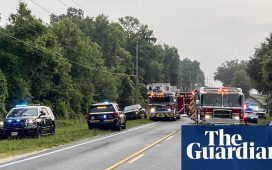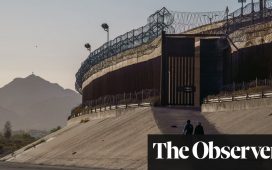Juanita Martinez stood on the muddy banks of the Rio Grande watching the iconic ribbon of water that marks the US-Mexico border. She was separated from the river by coils of razor wire and was just upstream from the infamous giant orange buoys installed to deter migrants from crossing into Texas. On the verge of tears, she said: “What have they done to our river?”
Nearby, old shipping containers were stacked, topped with more barbed wire. Martinez, an Eagle Pass native and chair of the local Maverick county Democratic party, told the Guardian: “It’s so inhumane to expose innocent migrants to this.”
On the Mexican side, families in Piedras Negras could stroll on the verdant riverbank, with children playing and people fishing.
On the US side, razor wire, shipping containers, Texas department of public safety troops and national guard soldiers from various states were staged on miles of bulldozed riverbank and strips of commandeered local land. Enforcing border laws is a federal duty, but Texas ensures it has state personnel patrolling in squad cars, air boats, military-style trucks and helicopters. There’s also the notorious 1,000-foot-long string of buoys, with netting underneath and saw-like blades between the floats.
This is Texas governor Greg Abbott’s “wall”. The rightwing Republican has made multibillion-dollar, anti-immigrant efforts to militarize the border, with his controversial Operation Lone Star, now assisted by many other Republican governors, from South Dakota to Florida, who have sent personnel or equipment.
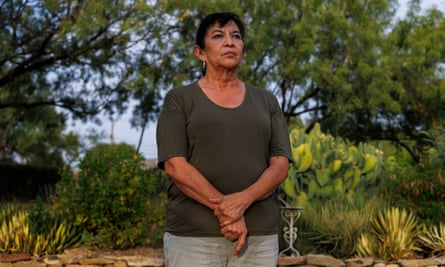
Abbott’s addition of a line of buoys in the river in July was a tactic too far for humanitarian and environmental critics – and the Biden administration. A federal judge is expected to rule soon on a lawsuit from the US Department of Justice that seeks to remove the $1m buoy barrier, claiming it violates the Rivers and Harbors Act of 1899.
Martinez scoffed at a letter Abbott sent to Joe Biden saying that the buoys were for migrants’ safety.
“He’s put the buoys in the place where the water is the lowest, so he’s pushing people to have to cross the river in [more] dangerous parts of the river.”
She noted that even if the buoys are removed, the brutal barrier of wire and armed personnel and their vehicles will remain.
The river at Eagle Pass is a typical crossing point for some of the thousands of migrants fleeing dire straits in Central America or as far away as Venezuela, Haiti, Cuba and even parts of Africa. The depth and currents are sometimes benign, sometimes lethal, with or without the buoys.
People want to bypass law enforcement or, very often, quickly turn themselves in to federal agents, to exercise their right to request asylum, having failed to get access to the highly restricted system. Abbott’s physical and human wall is meant to deter them.
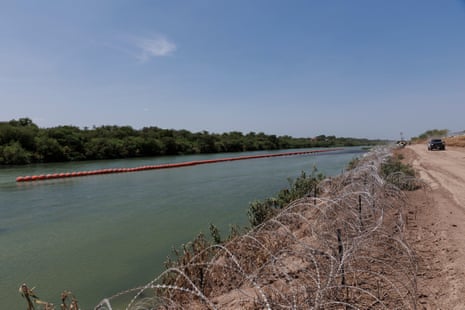

But for several days last week there were no migrants in sight on the Mexican bank or under the international bridge, where they often wait to cross the river by day or night. Local Mexican fishermen said it was too near the buoys, wire and troops, so people were trekking further upstream or downstream to cross with fewer obstacles.
Meanwhile, on the nine-hole city-owned golf course, games went on. Shipping containers are an eyesore and a sign at a bridge for golf carts to reach different holes now says: “US Govt property, no trespassing.”
But Vietnam war veteran and Donald Trump fan Danny Gutierrez Jr paused his practice to tell the Guardian that he approves of Abbott stepping up state law enforcement on the border, despite disruptions in Eagle Pass. “We all support them … because we want to feel secure while we’re playing a round of golf,” he said.
“We used to be playing … early in the morning and some people [immigrants] were walking out from behind the containers like they live there.” He accused migrants of trying to steal golf bags and also startling him by “jumping out” and talking to him.
after newsletter promotion
He also speculated that among what he described as good people trying to come to the US to seek asylum, there are “bad people” trying to smuggle drugs to “kill our little children”.
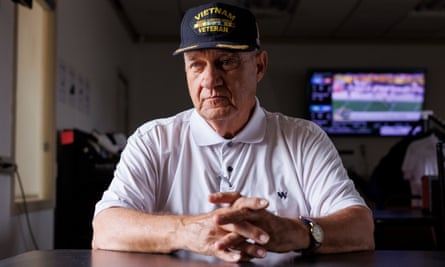
A fellow player, Guillermo Barrera, who crosses from his native Mexico most weekends for a round, said the heavy presence of law enforcement was “a distraction”.
“I’m not a very good golfer so having people near where you can hit someone is a thing to consider, so you play differently,” he said.
And he fears that a stray golf ball breaking a patrol car window could put him in a comprising position as he’s not a US citizen.
Abbott held a riverbank press conference last week with other GOP governors, surrounded by dozens of law enforcement, military vehicles, airboats and helicopters, as he touted Operation Lone Star.
To accommodate all this hardware and personnel, Texas has cleared vegetation and wildlife habitat and flattened some small islands in the river where migrants crossing often pause for breath, especially if they are struggling to keep their children safe.
Juanita Martinez’s daughter, Adriana Martinez, was born and raised in Eagle Pass but is now an associate professor at Southern Illinois University, where she’s a fluvial geomorphologist, researching how human activity shapes rivers.
She compared Abbott’s buoys to “a 1,000-foot-long chain of boulders in the middle of the channel”, changing the natural flow of the river, which violates treaties with Mexico and is potentially damaging.
“When we change water flow, we change erosion,” she said. Martinez noted that the Rio Grande floods and rising water and floating debris could hit the buoys, the concertina wire or the shipping containers, potentially causing them to become dislodged and washed downstream and causing major environmental and structural damage.
Back on the riverbank, her mother, Juanita Martinez, told nostalgic stories of fishing there with her grandfather. Then she called over to people fishing and relaxing on the Mexican side, shouting in Spanish: “Hello! We’re fighting so that they remove this fucking wire.”



